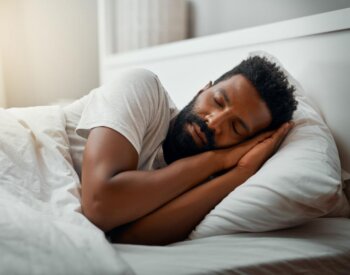
A cold room, not a warm bath, encourages sleep
If the recent change to daylight saving time is making it difficult to sleep at a regular bedtime, Okeanis Vaou, MD, FAAN, a UT Health San Antonio neurologist with a specialty in sleep medicine, said a warm glass of milk or warm bath before bed won’t encourage sleep. Instead, she recommends a cool, dark room.
“I have patients tell me they take a warm bath to help them go to sleep. But a warm bath may wake you up,” said Vaou. “When you are about to go to bed, you feel cold. That happens because your body cools you down preparing you for sleep. Your body turns off your internal thermostat to lower the temperature because that’s how our bodies prepare for sleep. Our brain wants a cooler temperature when we sleep.”
Vaou said the best room temperature for sleeping is 60–67 degrees Fahrenheit. She said moving the clock forward an hour each year takes the average person one to two weeks to adjust, but for some, it takes longer.
“People more prone to insomnia or sensitive to light changes have a harder time adjusting. Some people may never recover until the next change,” she said.
Younger and older most impacted
Vaou said older adults and teenagers are particularly affected by the time change. In a 2015 study published in the Journal of Clinical Sleep Medicine, teenagers lose an average of 32 minutes a day of sleep after springing forward, or close to three hours of sleep a week.
Sleeping and waking up is a biological function dictated by sunlight, said Vaou. The body’s circadian rhythm, or biological clock,

recognizes the lack or presence of light and therefore follows its pattern.
“With the direction of the sunlight, we wake up, and once the sun sets, we start preparing for bed,” she said. “It’s not just being sleepy, it’s all the other biological functions of our body such as digestion, blood pressure and even our mood.”
The American Academy of Sleep Medicine, a professional society for the subspecialty of sleep medicine, advises trying to slowly adjust your schedule. Vaou said good preparation for the time change includes waking up 15–20 minutes earlier than your usual bedtime for two to three days a week prior to the change, along with increased exposure to bright light in the morning.
However, if preparations aren’t made before the time change, Vaou and the Centers for Disease Control and Prevention recommend going to bed and waking up at the same time every day, including weekends, avoiding large meals before bed and exercising during the day but not close to bedtime.
Better sleep, better health
According to the CDC, one in three adults doesn’t get enough sleep. Sleeping less than the standard of seven to eight hours each night can contribute to chronic conditions like diabetes, heart disease, obesity and depression.
The American Academy of Sleep Medicine advocates for abolishing daylight saving time, arguing that the time change can lead to a higher risk of car accidents and increased cardiovascular events in the mornings. In 2020, the academy conducted an online survey about eliminating daylight saving time and adopting standard time year-round. Of those responding to the survey, 63 percent preferred standard time and not moving the clock forward each year.
While daylight saving time was first adopted in the United States in 1918 during World War I, primarily to conserve energy, the time change has been the subject of controversy for many years, with a growing number of states proposing legislation to abolish it. Texans may have the opportunity this coming November to determine the fate of daylight saving for the state with a proposed bill that would place the issue on the ballot.

